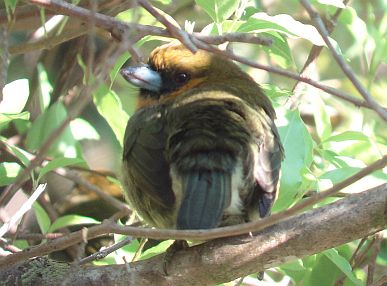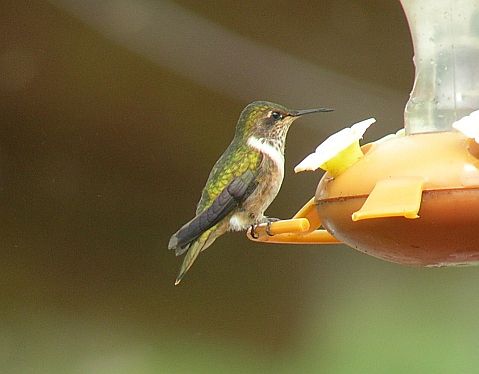Yes! I finally got a new bird for my Costa Rica list! I think the last addition was Blue-headed Vireo at the Children’s Forest Reserve above Grecia (although it was looking kind of like a Cassin’s…) but as rare as that species is for Costa Rica, I have witnessed its spectacled appearance since the 1980s. The bird I saw at Tapanti National Park, however, was a definite, long awaited life bird. Technically, I have seen it in Ecuador, but didn’t feel right about making an addition to my life list based on a brief glimpse of beige movement. I haven’t counted Rufous-vented Ground-Cuckoo nor Red-fronted Parrotlet for similar reasons. The non-countable sighting of the cuckoo was a look at a long tail of a bird that rushed off into the undergrowth at Quebrada Gonzalez while my two sightings of parrotlets were brief silhouettes- parrotlets obviously deserve better.
Fortunately, the new bird I saw on Sunday couldn’t have given better views and even sat long enough for one picture:

My lifer Ochre-breasted Antpitta from Tapanti National Park, Costa Rica.
I have visited Tapanti numerous times hoping for this bird and have seen the much larger Scaled Antpitta, uncommon foliage-gleaners, Ornate Hawk-Eagle, and even Rufous-rumped Antwren, but this little antpitta has always eluded me. Others have seen it at La Paz Waterfall Gardens, and (much more so) near the San Gerardo Station at Monteverde, but I always missed the bird at those places too. I don’t know where the Ochre-breasted Antpittas were hiding on my previous visits to Tapanti, but the bird on Sunday wasn’t feeling the least but shy. It got our attention with a raspy, antbird-like call, and shortly thereafter was spotted by Susan Blank. After getting that one shot, it moved to a few other visible perches before fitting too far away from the trail to see.
We saw my first countable Ochre-breasted Antpitta on the Arboles Caido trail about 200-300 meters up from the exit (it’s easier to walk up the trail from there). Walk this fairly steep trail and you might get lucky too! It may or may not respond to playback of recordings from Andean Ochre-breasted Antpittas because the birds in Costa Rica are said to give a rattling trill. This is particularly intriguing since Grallaricula antpitta species are thought to give either one note songs or trills but not both song types. Maybe some day, someone will show that the birds in Tapanti and elsewhere in Costa Rica merit species status.






